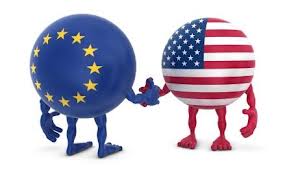US and EU: from competitor to partner in regionalism
- By Zhang Lijuan
 0 Comment(s)
0 Comment(s) Print
Print E-mail China.org.cn, February 22, 2013
E-mail China.org.cn, February 22, 2013

The United States and the EU, the two largest world trade players, are planning to work cooperatively on a new Transatlantic free trade agreement (FTA). The Transatlantic FTA, if accomplished, will be the largest and the most powerful regional FTA in modern international trade history.
According to the World Trade Organization (WTO), about 546 notifications of regional trade agreements (RTAs) had been received by January 10, 2013. For decades, scholars have been debating the challenges and benefits that RTAs have imposed on the multilateral trade regime and the WTO. With a Transatlantic FTA between the two leading members of the WTO, the future of the WTO is even more uncertain.
Between 1948 when the General Agreement on Tariffs and Trade (GATT) was created and 1995 when the WTO was established, the U.S. and EU were leading trade members. Until recently, neither the U.S. nor the EU has been willing to begin serious bilateral talks about a regional FTA between them. Both sides share a common understanding of what such a bilateral trade agreement means to the multilateral global trade regime.
However, RTAs are becoming so prevalent in today's international trade that bilateral and regional trading partners feel relatively comfortable making preferential deals within a limited scope of nations. On the contrary, the WTO, with 158 members as of Feb 2 this year, finds it very difficult to make further progress on multilateral trade negotiations.
As stated by the United States Trade Representative (USTR), transatlantic trade and investment are the backbone of the world economy. Together, the EU and the U.S. account for nearly half of the world's GDP and 30 percent of world trade. The U.S.-EU bilateral economic relationship has been a unique one in the world: they are competitors as well as partners.
As competitors, each side has pursued RTAs aggressively since the 1990s and sometimes competitions occur in strategic trade negotiations. For example, not until the EU and China reached an agreement on textile trade did the U.S. resume its negotiations with China on the same topic. The EU-Korea FTA entered into force in July 2011. Then the Korea-U.S. FTA became effective in March 2012. Ironically, the U.S. and the EU ended up with very similar terms in their respective bilateral trade agreements with the same partner nation.
As partners, the EU and the U.S. share world trade policy making cooperatively. Working together, the EU and the U.S. have built a wide-range of bilateral commercial diplomatic frameworks and share common interests under the Transatlantic Economic Council. In the face of the recent economic slowdown, both sides are working together to set up the U.S.-EU High Level Working Group on Jobs and Growth, which focuses on policies and measures to increase bilateral trade and investment as well as to create jobs and sustain global competitiveness.
Unlike any other RTAs, the U.S.-EU economic relationship has gone to business levels, including stakeholders from businesses, interest groups and private sectors. Because of their shared values in legal and market matters, U.S.-EU cooperation has permeated business dialogue and mechanics. No other trading partners can easily emulate this kind of cooperation.
There is one more common element worthy of note. Both the EU and the U.S. are good at maximizing economic growth through RTAs and bilateral FTAs. To some extent, the proposed Transatlantic FTA might serve as an efficient vehicle to solve their long-lasting major conflicts. Besides, another hope is that the Transatlantic FTA can improve regulatory harmonization and ideally promote full-acceptance of most, if not all, technical standards.
Agriculture trade is another focal point within U.S.-EU bilateral trade. While both sides insist heavy and direct government subsidies to domestic agricultural sectors, there has been virtually no progress in agriculture free trade during previous WTO negotiations. But how fast and how far the Transatlantic FTA can go is yet to be seen.
The author is a columnist with China.org.cn. For more information please visit: http://m.91dzs.com/opinion/zhanglijuan.htm
Opinion articles reflect the views of their authors, not necessarily those of China.org.cn.





